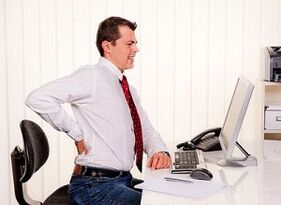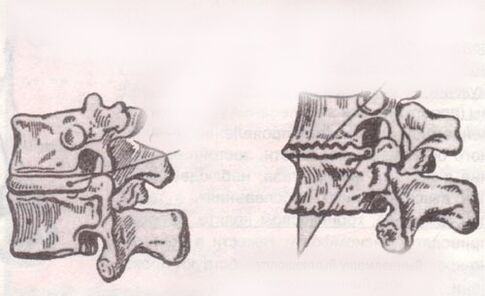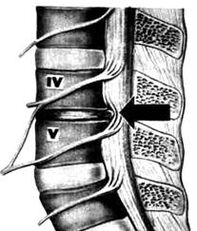Osteochondrosis of the lumbosacral spine is a dystrophic spinal disease, in which the normal structure of the entire spinal cord and more special intervertebral discs is gradually destroyed.It must be said that not only the back suffers, but the whole body, especially the pelvic organs and lower limbs.

The reasons for the development
The lumbar region of a person's life in connection with directness experiences a colossal vertical load, which cannot compensate for the large size of the vertebrae.Therefore, the smallest shifts in the human body, reduction of the muscle corset of the lower back, excess weight, injuries, improper movements and much more can lead to the development of the disease.Also, you should always remember the changes related to age in the spine with respect to each person.

By summarizing the above, the most common risk factors, whose totality leads to lumbar osteochondrosis can be distinguished:
- Uneven and irregular loads of the spine (lifting the weight from a sloping position, etc.).
- Excess weight (almost every kilogram is important).
- Rum injuries, including sports.
- Weakening of the muscle corset (prolonged work in a monotonous position, etc.).
- Insufficient diet, bad with minerals and vitamins.
Symptoms
The symptoms of the disease can vary quite widely, but the set of the main signs of osteochondrosis develops as a rule in three syndromes:
- Vertobrooogenous lumbalgia (synonym Lumbago).
- Vertro -carbon Lumboyshialgia.
- Vertro -Carbon ischialgia (inflammation of the sciatic nerve).
However, in Addition to Pain in the Lumbar Region (with Irradiation to the Legs, Gluteal, Inguinal Areas of Or Without Such), Tension of the Lower Back Muscles, Weakness in the LegsDifficulties of Movements in the Lumbar Region Should Be Distinguisted by a Number of Other Important Symptoms of Osteochondrosis of the Lumbar:
- Tingling in the legs and a feeling of crawling geese in the legs.
- Spasms in the legs.
- Pelvic disorders (delay or incontinence of urine, constipation or diarrhea).
- Weakness in certain groups of leg muscles.
These complaints can orient the neurologist to the level of spinal damage, make a differential diagnosis with other diseases of the spine.
Diagnostics and x -ray signs

Osteochondrosis should be diagnosed with only one type of instrumental methods - radiological.Visualize the Entire Structure of the Spine in Modern Medicine Allows the Best Msct or Mri Study, Howner, Simple Radiography has not Lost its estimated Value (AS A Screening Study).It is important to remember that the main stage of diagnosing spinal problems will be a medical examination, which sometimes allows you to diagnose without examination at all.
In the Neurological Status, Pain Is Detected on Palpation of the Spicy Processes of Vertebrae, Tension of the Lower Back Muscles, and IF There is: DecreneReflexes, Impaired Sensitivity, Symptoms of Tension (Signs of Compression of the Spinal Cord Roots), Impaired Muscle and Muscle of the Legs, Weakness of Movement of Movement of Motion.In the presence of these symptoms, a differential diagnosis with disc herniation and other, more serious diseases of the spine should be performed.
Treatment
The treatment of the disease involves prolonged complete therapy.The instructions for the treatment of several drugs to eliminate exacerbation, ancillary methods that are not preventive, and the preventive method of physiotherapy exercises, partially used in the acute period and does not lose its meaning to this day.
medication
It is a combination of myorlaxing therapy, anti -inflammatory pathogenetic therapy, and the use of neuroprotective drugs.The choice of drugs and dose calculations stems from the weight of a person, gender, the presence of concomitant diseases.
In the acute period, it is advisable to inject medicines such as diclofenac, meloxicam.Also, in parallel, they begin to perform therapy to remove muscle spasm and protect nerve fibers from damage.
Non -drug

It is represented by a person and manual influences.Given the massiveness of the muscle groups, a fairly broad level of the anatomical zone, the physiology can only be an auxiliary method.DDTs, electrophoresis, magnetotherapy are used, which allow you to improve the effect of medicines.
However, massage and manual therapy are sometimes able to completely stop the symptoms of lumbar osteochondrosis even without support for medication.This is due to the fact that muscle spasm can be removed quite well and the pain is not always provoked by the inflammatory process, sometimes only careless movement leads to pain, the consequences of which are eliminated effectively in the first hours after the development of pain.
Gymnastics for osteochondrosis of the lumbar region is aimed at stretching the muscles of the back and strengthening.In the presence of the established diagnosis, lumbar osteochondrosis should deal with physiotherapy exercises every day.Subject to general rules (limiting excessive physical activity, hypothermia), control of body weight and exercises for osteochondrosis of the lumbar region for the disease can sometimes be forgotten for many years.
























